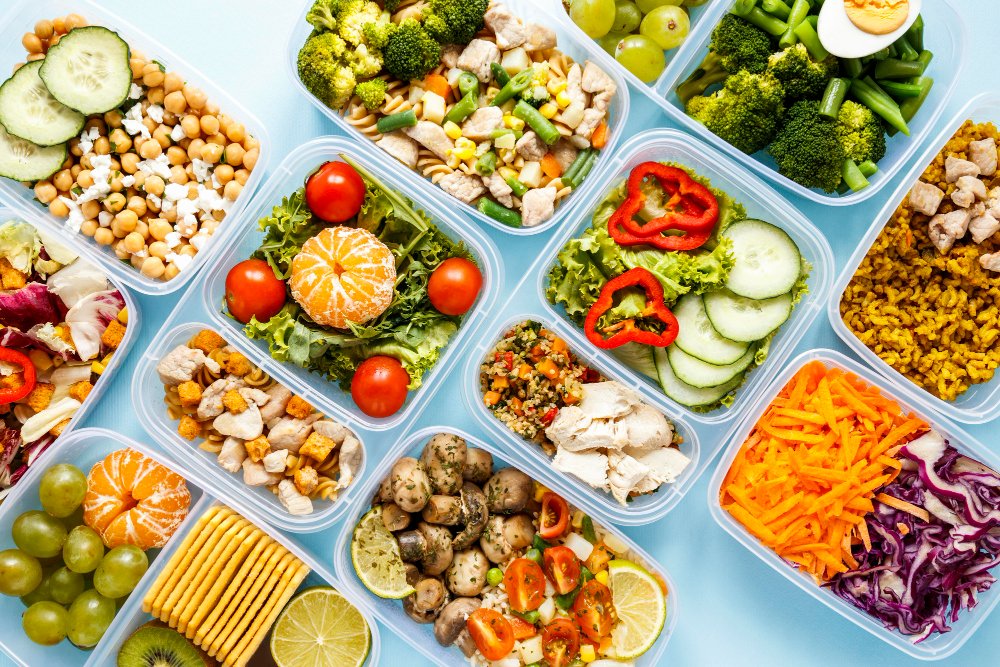Incorporating high fiber, low carb foods into your diet can have numerous benefits for your overall health and well-being. These types of foods are rich in essential nutrients and can help improve digestive health, aid in weight management, and reduce the risk of chronic diseases. By including a variety of fruits and vegetables, whole grains, legumes and beans, and nuts and seeds in your meals, you can create a balanced diet that supports your nutritional needs. Here are the key takeaways from this article:
Key Takeaways
- High fiber, low carb foods are beneficial for digestive health.
- Incorporating these foods into your diet can aid in weight management.
- A diet rich in high fiber, low carb foods can reduce the risk of chronic diseases.
- Fruits and vegetables, whole grains, legumes and beans, and nuts and seeds are excellent sources of high fiber, low carb foods.
- By planning your meals and incorporating these foods into your daily routine, you can enjoy the benefits of a high fiber, low carb diet.
Understanding High Fiber, Low Carb Foods

What are High Fiber, Low Carb Foods?
High fiber, low carb foods are a category of foods that are rich in dietary fiber and low in carbohydrates. These foods are known for their ability to provide a feeling of fullness and promote healthy digestion. They are also beneficial for managing blood sugar levels and supporting weight loss.
Incorporating high fiber, low carb foods into your diet can help you maintain a balanced and nutritious eating plan. By including a variety of these foods in your meals, you can ensure that you are getting the necessary nutrients while keeping your carbohydrate intake in check.
Here are some examples of high fiber, low carb foods:
| Food | Fiber Content (per serving) |
|---|---|
| Broccoli | 5 grams |
| Avocado | 9 grams |
| Chia Seeds | 10 grams |
Including these foods in your diet can provide numerous health benefits and contribute to overall well-being.
Why Should You Incorporate High Fiber, Low Carb Foods into Your Diet?
Incorporating high fiber, low carb foods into your diet offers numerous benefits for your overall health and well-being. Fiber plays a crucial role in maintaining a healthy digestive system by promoting regular bowel movements and preventing constipation. It also helps to keep you feeling fuller for longer, which can aid in weight management. Additionally, a diet rich in fiber has been linked to a reduced risk of chronic diseases such as heart disease, diabetes, and certain types of cancer.
To reap the benefits of high fiber, low carb foods, it’s important to include a variety of fruits and vegetables, whole grains, legumes and beans, and nuts and seeds in your daily meals. These foods are not only packed with fiber but also provide essential vitamins, minerals, and antioxidants that support overall health.
Here are some examples of high fiber, low carb foods that you can incorporate into your diet:
- Fruits and vegetables: Broccoli, spinach, berries, and avocados.
- Whole grains: Quinoa, brown rice, and oats.
- Legumes and beans: Lentils, chickpeas, and black beans.
- Nuts and seeds: Almonds, chia seeds, and flaxseeds.
By including these foods in your meals, you can create a balanced diet that is both nutritious and delicious. Remember to consult with a healthcare professional or registered dietitian for personalized advice and recommendations.
Tip: When incorporating high fiber, low carb foods into your diet, it’s important to drink plenty of water to help with digestion and prevent any potential digestive discomfort.
The Health Benefits of High Fiber, Low Carb Foods
Improved Digestive Health
Incorporating high fiber, low carb foods into your diet can have a positive impact on your digestive health. Fiber plays a crucial role in promoting regular bowel movements and preventing constipation. It adds bulk to your stool, making it easier to pass through the digestive system.
A diet rich in high fiber, low carb foods can also help maintain a healthy gut microbiome. The gut microbiome consists of trillions of bacteria that play a key role in digestion and overall health. Prebiotic fibers, found in foods like onions, garlic, and asparagus, act as fuel for beneficial gut bacteria, promoting their growth and diversity.
To ensure you’re getting enough fiber, include a variety of high fiber, low carb foods in your diet. Here are some examples:
| Food | Fiber Content |
|---|---|
| Avocado | 9 grams per cup |
| Broccoli | 5 grams per cup |
| Chia Seeds | 10 grams per ounce |
Remember to drink plenty of water when increasing your fiber intake to help prevent any potential digestive discomfort.
Tip: Gradually increase your fiber intake to allow your body to adjust and avoid any sudden digestive issues.
Weight Management
Incorporating high fiber, low carb foods into your diet can be beneficial for weight management. These foods are typically low in calories and high in fiber, which can help you feel fuller for longer and reduce cravings. Fiber is known to slow down digestion and promote a feeling of satiety, making it easier to control portion sizes and avoid overeating. Additionally, low carb foods can help regulate blood sugar levels and prevent spikes in insulin, which can contribute to weight gain.
To effectively manage your weight, consider including a variety of high fiber, low carb foods in your meals. Here are some examples:
- Leafy greens like spinach and kale
- Cruciferous vegetables such as broccoli and cauliflower
- Berries like raspberries and blackberries
- Lean proteins like chicken, turkey, and fish
Remember to consult with a healthcare professional or registered dietitian before making any significant changes to your diet or weight management plan.
Tip: When incorporating high fiber, low carb foods into your diet, it’s important to also focus on overall calorie intake and engage in regular physical activity for optimal weight management.
Reduced Risk of Chronic Diseases
Incorporating high fiber, low carb foods into your diet can significantly reduce the risk of chronic diseases. Research has shown that a diet rich in fiber and low in carbohydrates can help prevent conditions such as heart disease, type 2 diabetes, and colorectal cancer.
A study published in the Journal of the American Medical Association found that individuals who consumed a high fiber, low carb diet had a lower risk of developing heart disease compared to those who followed a standard Western diet. The high fiber content helps lower cholesterol levels and maintain healthy blood pressure, reducing the risk of cardiovascular problems.
Additionally, a low carb, high fiber diet can help regulate blood sugar levels and improve insulin sensitivity, making it beneficial for individuals with or at risk of type 2 diabetes. The fiber slows down the absorption of sugar, preventing spikes in blood glucose levels.
Furthermore, the increased consumption of fiber-rich foods can contribute to a reduced risk of colorectal cancer. Fiber promotes regular bowel movements and helps remove waste and toxins from the body, reducing the exposure of the colon to harmful substances.
To incorporate high fiber, low carb foods into your diet, consider including a variety of fruits and vegetables, whole grains, legumes and beans, and nuts and seeds. These foods are not only rich in fiber but also provide essential nutrients for overall health and well-being.
High Fiber, Low Carb Foods for a Balanced Diet

Fruits and Vegetables
Fruits and vegetables are essential components of a high fiber, low carb diet. They are rich in vitamins, minerals, and antioxidants that support overall health and well-being. Incorporating a variety of colorful fruits and vegetables into your meals can provide a range of nutrients and flavors.
To make it easier to include fruits and vegetables in your diet, you can try the following:
- Meal prepping: Wash, chop, and store fruits and vegetables in individual containers for quick and convenient access.
- Smoothies: Blend a combination of fruits and vegetables with a liquid of your choice for a refreshing and nutritious drink.
- Salads: Create colorful salads with a mix of leafy greens, sliced fruits, and vegetables. Add a protein source like grilled chicken or tofu for a complete meal.
Remember to choose organic and locally sourced produce whenever possible to maximize the nutritional benefits.
Tip: Experiment with different cooking methods, such as roasting, steaming, or grilling, to enhance the flavors of your fruits and vegetables.
Whole Grains
Whole grains are an essential part of a high fiber, low carb diet. They are rich in nutrients and provide a good source of energy. Quinoa is a versatile whole grain that is packed with protein and fiber. It can be used as a base for salads, added to soups, or used as a substitute for rice. Other examples of whole grains include oats, brown rice, and barley.
- Quinoa
- Oats
- Brown rice
- Barley
Incorporating these whole grains into your meals can help you feel fuller for longer and provide sustained energy throughout the day. They are also a great source of vitamins, minerals, and antioxidants that support overall health.
Tip: When buying whole grain products, look for labels that indicate they are made from 100% whole grains to ensure you are getting the maximum nutritional benefits.
Legumes and Beans
Legumes and beans are excellent sources of both fiber and protein. They are low in carbs and can be a great addition to a balanced diet. Black beans, for example, are rich in fiber, which helps promote healthy digestion and prevent constipation. They also provide a good amount of protein, making them a suitable choice for vegetarians and vegans.
Incorporating legumes and beans into your meals is easy. You can add them to salads, soups, or stews for an extra boost of nutrition. They can also be used as a base for vegetarian burgers or as a filling for tacos or burritos. Here are some ideas to include legumes and beans in your diet:
- Make a chickpea salad with tomatoes, cucumbers, and feta cheese.
- Prepare a lentil soup with carrots, celery, and spices.
- Enjoy a black bean and corn salsa with tortilla chips as a snack.
Tip: Soaking legumes and beans overnight can help reduce cooking time and improve their digestibility.
Nuts and Seeds
Nuts and seeds are excellent sources of healthy fats, protein, and fiber. Incorporating a variety of nuts and seeds into your diet can provide numerous health benefits. Almonds are a popular choice and are rich in vitamin E, magnesium, and antioxidants. Chia seeds are another great option as they are packed with omega-3 fatty acids and fiber.
Including nuts and seeds in your meals can be as simple as sprinkling them on top of salads, yogurt, or oatmeal. They can also be used as a crunchy topping for roasted vegetables or added to homemade granola bars for an extra nutritional boost.
Here are some examples of nuts and seeds and their nutritional content:
| Nut/Seed | Nutritional Content |
|---|---|
| Almonds | High in vitamin E, magnesium, and antioxidants |
| Chia seeds | Packed with omega-3 fatty acids and fiber |
Incorporating a variety of nuts and seeds into your diet can help improve heart health, promote satiety, and support weight management. Remember to consume them in moderation as they are calorie-dense.
Tip: Store nuts and seeds in airtight containers in a cool, dark place to maintain their freshness and prevent them from going rancid.
Incorporating High Fiber, Low Carb Foods into Your Daily Meals

Breakfast Ideas
When it comes to incorporating high fiber, low carb foods into your breakfast, there are plenty of delicious options to choose from. Here are a few ideas to get you started:
- Eggs and Vegetables: Start your day with a protein-packed breakfast by making an omelette or scrambled eggs with a variety of colorful vegetables like spinach, bell peppers, and mushrooms.
- Greek Yogurt with Berries: Enjoy a creamy and satisfying breakfast by combining Greek yogurt with a handful of fresh berries like strawberries, blueberries, or raspberries. This combination provides a good balance of protein, fiber, and antioxidants.
- Chia Seed Pudding: Prepare a nutritious and filling breakfast by soaking chia seeds in your choice of milk (such as almond milk or coconut milk) overnight. In the morning, top it with your favorite low carb fruits like sliced almonds or unsweetened coconut flakes.
Remember, starting your day with a high fiber, low carb breakfast can help you feel energized and satisfied until your next meal.
Lunch and Dinner Recipes
When it comes to incorporating high fiber, low carb foods into your lunch and dinner meals, there are plenty of delicious options to choose from. Here are a few ideas to get you started:
- Grilled Chicken Salad: Start with a bed of mixed greens and top it with grilled chicken, cherry tomatoes, cucumbers, and avocado. Drizzle with a light vinaigrette dressing for a satisfying and nutritious meal.
- Zucchini Noodles with Meatballs: Replace traditional pasta with zucchini noodles and serve them with homemade meatballs and marinara sauce. This low carb alternative is packed with flavor and nutrients.
- Cauliflower Fried Rice: Swap out rice for cauliflower rice and stir-fry it with your favorite vegetables, lean protein, and a splash of soy sauce. This tasty dish is a great way to enjoy a low carb version of a classic.
Remember, the key to incorporating high fiber, low carb foods into your meals is to get creative and experiment with different ingredients and flavors. Enjoy exploring new recipes and discovering the benefits of a balanced diet!
Snack Options
When it comes to snack options, there are plenty of high fiber, low carb choices that can satisfy your cravings while keeping you on track with your healthy eating goals. Here are a few ideas:
- Mixed nuts: A handful of mixed nuts, such as almonds, walnuts, and cashews, can provide a satisfying crunch and a good dose of healthy fats and fiber.
- Greek yogurt: Opt for plain Greek yogurt, which is low in carbs and high in protein. Add some berries or a sprinkle of cinnamon for extra flavor.
- Vegetable sticks with hummus: Cut up some carrots, celery, and bell peppers and pair them with a serving of hummus for a nutritious and filling snack.
Remember to choose snacks that are nutrient-dense and provide a good balance of macronutrients. These options can help keep you feeling satisfied between meals and support your overall health and well-being.
Tips for Meal Planning
When incorporating high fiber, low carb foods into your daily meals, it’s important to plan ahead to ensure a balanced and nutritious diet. Here are some tips to help you with meal planning:
- Make a weekly meal plan: Take some time at the beginning of each week to plan out your meals. This will help you stay organized and make healthier choices.
- Include a variety of foods: Aim to include a mix of fruits, vegetables, whole grains, legumes, and nuts/seeds in your meals. This will provide you with a wide range of nutrients.
- Prep ingredients in advance: Spend some time prepping ingredients, such as chopping vegetables or cooking grains, ahead of time. This will save you time during the week and make it easier to stick to your meal plan.
- Cook in batches: Consider cooking larger portions of meals and storing leftovers for future meals. This can save you time and ensure you always have a healthy option available.
- Stay hydrated: Don’t forget to drink plenty of water throughout the day. Staying hydrated is important for overall health and can help with digestion.
Remember, meal planning is a personal process, so find a method that works best for you and your lifestyle.
Conclusion

Incorporating high fiber, low carb foods into your diet can have numerous benefits for your overall health and well-being. Fiber is essential for maintaining a healthy digestive system and can help prevent constipation and promote regular bowel movements. Additionally, a low carb diet can aid in weight loss and improve blood sugar control, making it beneficial for individuals with diabetes or those looking to manage their weight. By including foods such as fruits, vegetables, whole grains, and legumes in your meals, you can increase your fiber intake while reducing your carbohydrate consumption. So, why not start incorporating these nutritious foods into your diet today and reap the many benefits they have to offer?
Frequently Asked Questions
What are high fiber, low carb foods?
High fiber, low carb foods are foods that contain a significant amount of dietary fiber while being low in carbohydrates. These foods are often plant-based and include fruits, vegetables, whole grains, legumes, nuts, and seeds.
Why are high fiber, low carb foods beneficial for your health?
High fiber, low carb foods offer several health benefits. They promote improved digestive health, help with weight management, and reduce the risk of chronic diseases such as heart disease, diabetes, and certain types of cancer.
How do high fiber, low carb foods improve digestive health?
High fiber, low carb foods add bulk to the stool, making it easier to pass through the digestive system. They also promote regular bowel movements and prevent constipation.
Can high fiber, low carb foods help with weight management?
Yes, high fiber, low carb foods can be beneficial for weight management. They provide a feeling of fullness and satiety, which can help control appetite and prevent overeating. Additionally, they often have fewer calories compared to high carb foods.
Are there any specific high fiber, low carb foods recommended for a balanced diet?
Yes, there are several high fiber, low carb foods that are recommended for a balanced diet. These include fruits and vegetables, whole grains, legumes and beans, and nuts and seeds.
How can I incorporate high fiber, low carb foods into my daily meals?
You can incorporate high fiber, low carb foods into your daily meals by including fruits and vegetables in every meal, opting for whole grain products, adding legumes and beans to soups and salads, and including nuts and seeds as snacks or toppings.






